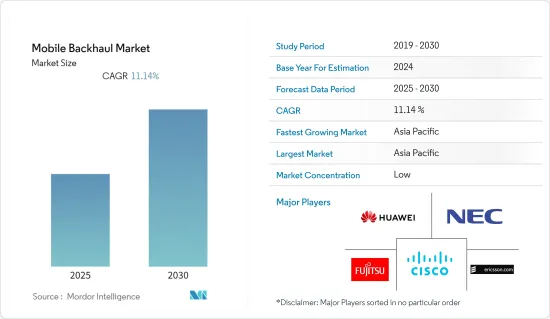
|
시장보고서
상품코드
1629787
모바일 백홀 : 시장 점유율 분석, 산업 동향 및 통계, 성장 예측(2025-2030년)Mobile Backhaul - Market Share Analysis, Industry Trends & Statistics, Growth Forecasts (2025 - 2030) |
||||||
모바일 백홀 시장은 예측 기간 동안 CAGR 11.14%를 기록할 것으로 예상됩니다.

주요 하이라이트
- 백홀은 무선 셀 사이트에서 백본 코어 네트워크의 입구/출구 지점에 있는 에지 스위치까지 음성 및 데이터 트래픽을 전송하는 것을 말합니다. 모바일 백홀의 주요 목적은 사용자 데이터를 수집하여 학술 기관, 정부 기관, 중요 기관, 인터넷 등의 네트워크로 전송하는 것입니다. 또한 대량의 데이터를 처리하고 전달하여 사용자 경험을 크게 향상시킬 수 있습니다.
- 스마트폰 등 커넥티드 기기에 대한 수요가 점차 증가하고 있으며, 이는 시장 성장의 원동력이 되고 있습니다. 또한, 고속 음성 및 데이터 서비스를 위한 비용 효율적인 백홀을 제공하는 등 포인트 투 포인트 마이크로파 전송 기술의 사용이 증가함에 따라 이 시장의 성장을 촉진할 것으로 예상됩니다. 스몰셀의 보급과 스마트폰의 높은 보급률 등 여러 요인이 시장 성장에 기여하고 있습니다.
- 디지털 기술의 발전과 인터넷 연결 수준의 향상으로 스트리밍 서비스에 대한 의존도가 높아지고, 4G 네트워크가 주로 지원하는 AR/VR, 4k/8k 동영상, 360도 동영상 스트리밍은 5G의 동영상 콘텐츠가 몰입감을 높여 전체 데이터 트래픽에서 차지하는 소비 비중이 높아질 것으로 예상되며, 시장 수요를 증가시킬 것입니다.
- LTE-Advanced Pro 또는 4.5G로 알려진 LTE는 IoT 연결을 위한 피크 대역폭 확대, 에너지 효율성 향상 등 여러 가지 기술적 진보를 통해 4.5G의 피크 대역폭은 약 1gbps로 일반 LTE의 8-10배에 달하며, 모바일 기기가 4K 화질의 비디오 트래픽을 처리할 수 있습니다. 10배에 해당하며, 모바일 기기가 4K 화질의 비디오 트래픽을 처리할 수 있게 해줍니다. 일부 산업 발전은 MNO의 네트워크 백홀 인프라에 새로운 도전과 요구사항을 제기할 것입니다.
- 모바일 백홀에 대한 수요는 모바일 데이터 트래픽과 음성 트래픽의 증가로 인해 팬데믹 기간 동안 새로운 추세를 보였습니다. 또한 기업들은 건강 위기의 영향에 대응하기 위해 디지털 혁신 노력을 강화했습니다. 비디오, 컨텐츠, 소셜 미디어에 대한 최종사용자의 수요가 점점 더 높아지고 원격 근무의 필요성이 증가함에 따라 대역폭이 많은 트래픽을 처리하기 위해 차세대 연결에 대한 의존도가 지속적으로 증가하고 있습니다. 팬데믹 이후 스마트폰 가입자와 인터넷 보급률이 증가함에 따라 시장은 빠르게 성장하고 있습니다.
모바일 백홀 시장 동향
스마트폰 및 커넥티드 디바이스 수요 확대가 시장 성장 견인
- 브로드밴드 이용 증가에 대응하기 위해 모바일 네트워크의 발전이 진행되고 있습니다. 모바일 데이터 서비스는 네트워크 사용자의 필수 요건이 되고 있습니다. 백홀 서비스 포트폴리오는 통신 사업자가 기술 혁신과 품질에 직접적으로 접근할 수 있게 해줍니다. 백홀 서비스의 장점은 스마트폰 사용자에게 향상된 용량, 접근성 및 데이터 속도를 제공한다는 점입니다.
- 지역별 시장 환경에 따라 트래픽 증가율은 해마다 변동하며, 국가별로도 큰 차이를 보입니다. 전 세계적으로 스마트폰 1대당 모바일 데이터 트래픽의 증가는 세 가지 주요 요인에 기인합니다. 에릭슨에 따르면, 스마트폰당 월평균 모바일 데이터 사용량이 4.6기가바이트(GB)로 추정되는 사하라 사막 이남 지역과 지난해 스마트폰당 월평균 4.6기가바이트(GB)로 추정되는 사하라 사막 이남 아프리카의 데이터 사용량 증가는 이 세 가지 주요 요인에 기인합니다. 사하라 사막 이남 아프리카 지역과 지난해 스마트폰 1대당 월평균 모바일 데이터 사용량이 25GB인 걸프협력회의(GCC) 국가들에서 볼 수 있습니다. 전 세계 스마트폰 1대당 월평균 사용량은 19GB이며, 향후 5년간 46GB에 달할 것으로 예상됩니다.
- 전 세계적으로 IoT의 높은 도입률로 인한 커넥티드 디바이스 사용의 대폭적인 증가가 모바일 백홀 시장을 견인할 것으로 예상됩니다. 모바일 데이터 트래픽은 예측 기간 동안 급증할 것으로 예상되며, 에릭슨에 따르면 북미의 경우 단말기 당 월별 모바일 데이터 트래픽이 26.76GB에 달했습니다. 중동 및 아프리카에서는 올해 11.01GB를 기록했습니다. 향후 4년간 서유럽의 단말기당 월평균 데이터 트래픽은 51.31GB에 달할 것으로 추정됩니다.
- 소셜 미디어 애플리케이션에 동영상이 통합되고 소비자들이 온라인에서 TV를 시청하는 기회가 증가함에 따라 소비자들은 더 빠르고 안정적인 인터넷 연결을 계속 요구하고 있습니다. 통신 사업자들은 사용자 경험을 개선하고 시장 점유율을 유지 또는 확대하기 위해 인프라에 지속적으로 투자할 가능성이 있습니다.
아시아태평양이 가장 빠른 성장 시장으로 부상할 전망
- 지역 내 연결성이 증가함에 따라, 셀룰러 백홀 수요와 위성 베이스 백홀은 큰 성장을 보인 후 아시아에서 우위를 유지할 것으로 보입니다. 아시아 각국에서 새로운 LTE 라이센스가 생겨나고 지방의 광대역 서비스가 확대됨에 따라, 커버리지 문제뿐만 아니라 신규 고객을 빠르게 확보하기 위해 모든 곳에서 위성 서비스에 대한 수요가 증가하고 있습니다. 아시아에서 위성을 통한 셀룰러 백홀에 대한 수요는 확실히 강하며, 이는 모바일 백홀에 대한 수요와도 일치합니다.
- 아시아태평양 국가들은 음성 위주의 휴대폰 사용에서 비디오 스트리밍, 원격의료, 전자 농업, 원격 학습 등 데이터 집약적인 클라우드 중심 애플리케이션으로 전환하고 있습니다. 그러나 지역, 인프라 안정성, 낮은 인구 밀도 등의 문제로 인해 많은 국가에서 농촌 및 원격지에 서비스를 제공해야 하는 어려움이 있습니다.
- 신흥국 시장에서는 스마트폰과 모바일 기기의 보급이 활발하게 이루어지고 있어 여러 반도체 및 모바일 기기 제조업체가 존재하고 있는 것이 시장을 뒷받침하고 있습니다. 또한, 이 지역의 공급망은 시장을 보완하는 역할을 하고 있습니다. 이러한 생태계 덕분에 이 시장은 빠르게 성장하고 있습니다.
- 모바일 네트워크는 인도, 네팔, 부탄의 사회경제적 포용성 확대에 중요한 역할을 하고 있으며, 5G는 인도의 디지털 포용성 목표 달성, 특히 농촌 및 외딴 지역에 대한 광대역 보급에 필수적인 요소로 간주됩니다. 모바일 광대역의 개선은 시민들이 공공 서비스에 접근할 수 있도록함으로써 정부의 '디지털 인디아' 비전의 토대를 마련하고 있습니다.
- Ericsson에 따르면, 스마트폰 1대당 평균 데이터 트래픽은 지난해월 25GB에서 향후 5년간월 약 54GB로 증가할 것으로 예상되며, 이는 CAGR 14%에 해당합니다. 인도의 총 모바일 데이터 트래픽은 전년도월 18엑사바이트(EB)에서 향후 5년간월 53EB로 CAGR 19%로 증가할 것으로 예상됩니다. 이는 스마트폰 사용자의 급속한 증가와 스마트폰의 평균 사용량 증가에 기인합니다. 동남아시아 및 오세아니아의 스마트폰 1대당 모바일 데이터 트래픽은 2028년 약 54GB/월에 달할 것으로 예상되며, CAGR 28%로 가장 빠르게 성장하는 지역이 될 것으로 전망됩니다.
모바일 백홀 산업 개요
모바일 백홀 시장은 세계 진입 기업과 중소기업이 모두 존재하기 때문에 매우 세분화되어 있습니다. 많은 중소기업은 시스템 및 네트워크 통합과 같은 특정 기능에 대한 전문성을 가지고 있지만, 모바일 백홀 솔루션의 전체 영역을 제공할 수 있을 만큼 규모가 크지 않습니다. 주요 시장 진입 업체로는 Fujitsu LimitedFujitsu Limited, NEC Corporation, Ericsson Inc. 시장 진입 기업들은 파트너십, 합병, 기술 혁신, 투자, 인수 등의 전략을 채택하여 제품을 강화하고 지속적인 경쟁 우위를 확보하기 위해 노력하고 있습니다.
뉴사우스웨일스(NSW) 통신공사는 2022년 10월, 새로운 전략적 제휴의 일환으로 NEC를 선택해 첨단 5G 혁신 연구소의 첫 번째 단계를 구축하기로 했습니다. 이 새로운 5G 혁신 연구소는 뉴사우스웨일즈 통신공사와 공공안전 기관이 새로운 기술을 실험하고, 상호 운용성을 입증하며, 공공안전 모바일 브로드밴드(PSMB) 애플리케이션의 맥락에서 모바일 기술의 역량을 강화할 수 있는 공간을 제공합니다. NSW Telco Authority의 중요한 파트너로, ITS2573 NSW 정부 조달 패널에 따라 NSW 공공안전 네트워크(PSN) 구상에 무선 백홀 솔루션을 공급해 왔습니다.
노키아는 2022년 4월, 다른 마이크로파 대역보다 훨씬 더 넓은 대역폭을 제공하는 D밴드 주파수 대역(130-175GHz)을 이용한 마이크로파 링크의 라이브 시연에 성공했다고 발표했습니다. 노키아는 노키아 벨 연구소(Nokia Bell Labs)의 장비를 사용하여 100GHz 이상의 고주파 대역이 어떻게 모바일 네트워크 백홀에 일반적으로 사용되는 마이크로파 대역에 비해 엄청난 채널 대역폭을 구현하여 최대 50배의 트래픽을 전송할 수 있는지에 대한 시연을 성공적으로 수행했다고 밝혔습니다. 최대 50배의 트래픽을 전송할 수 있는지를 조사했습니다.
기타 혜택
- 엑셀 형식의 시장 예측(ME) 시트
- 3개월간 애널리스트 지원
목차
제1장 소개
- 조사 가정과 시장 정의
- 조사 범위
제2장 조사 방법
제3장 주요 요약
제4장 시장 인사이트
- 시장 개요
- 산업 밸류체인 분석
- 산업의 매력 - Porter's Five Forces 분석
- 신규 참여업체의 위협
- 구매자/소비자의 협상력
- 공급 기업의 교섭력
- 대체품의 위협
- 경쟁 기업 간의 경쟁 관계
- 기술 현황
- COVID-19가 시장에 미치는 영향
제5장 시장 역학
- 시장 역학 채용
- 시장 성장 촉진요인
- 스마트폰과 커넥티드 디바이스 수요 확대
- 데이터 소비 고속화로 이어지는 5G 보급
- 시장 성장 억제요인
- 높은 초기 투자 비용이 억제요인으로
제6장 시장 세분화
- 전개별
- 유선
- 무선
- 포인트 투 포인트 네트워크
- 포인트 투 멀티포인트 네트워크
- 기타 무선 네트워크
- 유형별
- 솔루션
- 서비스별
- 지역별
- 북미
- 유럽
- 아시아태평양
- 라틴아메리카
- 중동 및 아프리카
제7장 경쟁 구도
- 기업 개요
- Fujitsu Limited
- NEC Corporation
- Ericsson Inc.
- Huawei Technologies
- Cisco Systems Inc.
- Aviat Networks Inc.
- AT&T Inc.
- ZTE Corporation
- BridgeWave Communications Inc.(Remec Broadband Wireless International)
- Ceragon Networks Ltd
제8장 투자 분석
제9장 시장 전망
ksm 25.01.23The Mobile Backhaul Market is expected to register a CAGR of 11.14% during the forecast period.

Key Highlights
- Backhaul is the transport of voice and data traffic from a radio cell site to an edge switch at the ingress/egress point of the backbone core network. Mobile backhaul's primary purpose is to gather user data and transfer it to a network, such as an academic institution, government agency, significant institution, or the internet. It can also handle and distribute massive volumes of data, significantly improving the user experience.
- The demand for connected devices such as smartphones is increasing gradually, which drives market growth. The increasing use of point-to-point microwave transport technology is also expected to drive the growth of this market due to its offerings, such as cost-effective backhauling for high-speed voice and data services. Several factors, such as the proliferation of small cells and the high penetration of smartphones, contribute to the market's growth.
- Due to advancements in digital technology and the connectivity level of the internet, with increased dependence on streaming services, 4G networks supported majorly, streaming with AR/VR, 4k/8k video, and 360-degree videos, the 5G video content is expected to be immersive and consuming a higher proportion of the overall data traffic increase the demand of the market.
- Several technological advances are taking place on LTE, known as LTE-Advanced Pro or 4.5G, which provide enhancements such as increased peak bandwidth and energy efficiency for IoT connectivity. The peak bandwidth of 4.5G is approximately 1gbps, which is 8-10x more than regular LTE and would allow mobile devices to accommodate video traffic at 4K quality, among other things. Several industry developments result in new challenges and requirements for MNO network backhaul infrastructure.
- The demand for mobile backhaul requirements saw a new trend during the pandemic due to the growing mobile data traffic and voice. Enterprises also ramped up their digital transformation efforts to combat the effects of the health crisis. With ever-growing end-user demand for video, content, and social media, and a need to work remotely, the reliance on next-generation connectivity to cope with bandwidth-heavy traffic has always been higher. After the pandemic, the market is growing rapidly with an increased number of smartphone subscriptions and internet penetration.
Mobile Backhaul Market Trends
Growing Demand for Smartphones and Connected Devices Drives the Market Growth
- Mobile networks are being developed to respond to the growing broadband usage. Mobile data services are well on to becoming a requirement for network consumers. A backhaul service portfolio gives operators direct access to innovation and quality. The benefits of backhaul services are the ability, accessibility, and increasing data speed for smartphone users.
- Depending on local market conditions, traffic growth can be volatile between years and vary significantly between nations. Globally, the increase in mobile data traffic per smartphone can be attributed to three key drivers: increased device capabilities, data-intensive content, and data consumption as network performance continues to improve. According to Ericsson, these differences can be seen in Sub-Saharan Africa, where the average monthly mobile data usage per smartphone is estimated to be 4.6 gigabytes (GB), and the Gulf Cooperation Council (GCC) countries, where the average monthly mobile data usage per smartphone was 25 GB last year. The global monthly average consumption per smartphone is expected to be 19 GB, which is expected to reach 46 GB by the next five years.
- Globally, a significant rise in the use of connected devices, owing to the high adoption of IoT, is expected to drive the market for mobile backhaul. Mobile data traffic is expected to increase rapidly during the forecast period. According to Ericsson, the monthly mobile data traffic per device reached 26.76 GB in North America. In the Middle East and Africa, that number stood at 11.01 GB in the current year. By the next four years, it is estimated that the average monthly data traffic per device in Western Europe would reach 51.31 GB.
- Consumers continue to demand faster and more reliable internet connections as video becomes more embedded in social media applications, and consumers increasingly watch TV online. The carriers may continue to invest in their infrastructure to improve the user experience and maintain, or attempt to grow, the market share.
Asia Pacific is Expected to be the Fastest Growing Market
- As connectivity within the region increases, the cellular backhaul demand and satellite-based backhaul would keep their prominence in Asia after seeing significant growth. With new LTE licenses popping up in every country in Asia and the growth of broadband services in rural areas, there is now a strong need for satellite services everywhere, not only for coverage matters but also for the fast acquisition of new customers. The demand in Asia for cellular backhaul by satellite is certainly strong, which caters to a demand for mobile backhaul.
- Countries across Asia-Pacific are transitioning from voice-only mobile phone use to data-intensive and cloud-centric applications, including video streaming, telemedicine, e-agriculture, and distance learning. However, many countries' rural and remote areas need to be served due to geography, infrastructure reliability, and low population density challenges.
- The presence of multiple semiconductors and mobile device manufacturers helped the market, as the adoption and penetration of smartphone and mobile devices in the developing region have been high. Additionally, this has allowed supply chain presence in the region to complement the market. The ecosystem supporting the market has allowed the market to remain a rapidly growing market.
- Mobile networks continue to play an important role in increasing social and economic inclusion in India, Nepal, and Bhutan. 5G would be essential to achieving India's digital inclusion goals, particularly extending broadband to rural and distant residences. The improved mobile broadband is creating the groundwork for the government's "Digital India" vision by allowing citizens to access public services.
- According to Erisccson, the average data traffic per smartphone is expected to rise from 25 GB per month last year to approximately 54 GB per month by the next five years, representing a 14% CAGR. Total mobile data traffic in India is expected to expand at a 19% CAGR from 18 exabyte (EB) per month in the previous year to 53 EB per month by the next five years. This is due to rapid growth in smartphone users and an increase in average smartphone usage. Mobile data traffic per smartphone in South East Asia and Oceania is predicted to reach approximatly 54 GB per month in 2028, a CAGR of 28 percent, making it the fastest-growing area.
Mobile Backhaul Industry Overview
The Mobile Backhaul Market is highly fragmented due to the presence of both global players and small and medium-sized enterprises. Many small players have expertise in certain functionalities, like system or network integration, but are not big enough to provide the entire spectrum of mobile backhaul solutions. The major players in the market are Fujitsu Limited, NEC Corporation, Ericsson Inc., Huawei Technologies, and Cisco Systems Inc., among others. Players in the market adopt strategies such as partnerships, mergers, innovations, investments, and acquisitions to enhance their offerings and gain sustainable competitive advantage.
In October 2022, the New South Wales (NSW) Telco Authority chose NEC Corporation to create the first phase of an advanced 5G innovation lab as part of a new strategic collaboration. The new 5G innovation lab would provide a space for the NSW Telco Authority and public safety agencies to experiment with new technologies, demonstrate interoperability, and push the capabilities of mobile technology in the context of Public Safety Mobile Broadband (PSMB) applications. NEC has long been a significant partner of the NSW Telco Authority, supplying wireless backhaul solutions for the NSW Public Safety Network (PSN) initiative under the ITS2573 NSW Government procurement panel.
In April 2022, Nokia announced the successful demonstration of a live microwave link using the D-Band spectrum (130-175 GHz), which provides much more bandwidth than other microwave bands and serves as an ultra-high-capacity extension for 5G backhaul and fronthaul in crowded metropolitan contexts. The research, which was carried out by Nokia using Nokia Bell Labs equipment, looked into how higher frequencies above 100 GHz may enable enormous channel bandwidths and carry up to 50 times more traffic than microwave bands commonly utilized for mobile network backhaul.
Additional Benefits:
- The market estimate (ME) sheet in Excel format
- 3 months of analyst support
TABLE OF CONTENTS
1 INTRODUCTION
- 1.1 Study Assumptions? and Market Definition?
- 1.2 Scope of the Study
2 RESEARCH METHODOLOGY
3 EXECUTIVE SUMMARY
4 MARKET INSIGHTS
- 4.1 Market Overview
- 4.2 Industry Value Chain Analysis
- 4.3 Industry Attractiveness - Porter's Five Forces Analysis
- 4.3.1 Threat of New Entrants
- 4.3.2 Bargaining Power of Buyers/Consumers
- 4.3.3 Bargaining Power of Suppliers
- 4.3.4 Threat of Substitute Products
- 4.3.5 Intensity of Competitive Rivalry
- 4.4 Technology Snapshot
- 4.5 Impact of COVID-19 on the Market
5 MARKET DYNAMICS
- 5.1 Introduction to Market Dynamics
- 5.2 Market Drivers
- 5.2.1 Growing Demand for Smartphones and Connected Devices
- 5.2.2 Proliferation of 5G Leading to Faster Consumption of Data
- 5.3 Market Restraints
- 5.3.1 High Initial Investment Cost to Act as a Restraint
6 MARKET SEGMENTATION
- 6.1 By Deployment
- 6.1.1 Wired
- 6.1.2 Wireless
- 6.1.2.1 Point-to-Point Network
- 6.1.2.2 Point-to-Multipoint Network
- 6.1.2.3 Other Wireless Networks
- 6.2 By Type
- 6.2.1 Solution
- 6.2.2 Services
- 6.3 By Geography
- 6.3.1 North America
- 6.3.2 Europe
- 6.3.3 Asia-Pacific
- 6.3.4 Latin America
- 6.3.5 Middle East & Africa
7 COMPETITIVE LANDSCAPE
- 7.1 Company Profiles
- 7.1.1 Fujitsu Limited
- 7.1.2 NEC Corporation
- 7.1.3 Ericsson Inc.
- 7.1.4 Huawei Technologies
- 7.1.5 Cisco Systems Inc.
- 7.1.6 Aviat Networks Inc.
- 7.1.7 AT&T Inc.
- 7.1.8 ZTE Corporation
- 7.1.9 BridgeWave Communications Inc. (Remec Broadband Wireless International)
- 7.1.10 Ceragon Networks Ltd



















